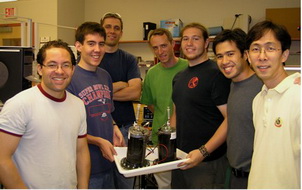A herbivorous fuel cell will charge your mobile in just six months.
 The BioVolt student team from the Massachusetts Institute of Technology has developed a microbial fuel cell that runs on cellulosic biomass, such as foliage or grass. Their prototype won first place (and $ 5,000) at the MADMEC competition held under the auspices of the institute and the Dow Chemical company, and designed to encourage the use of new approaches in materials science for the development of alternative and unconventional energy sources.
The BioVolt student team from the Massachusetts Institute of Technology has developed a microbial fuel cell that runs on cellulosic biomass, such as foliage or grass. Their prototype won first place (and $ 5,000) at the MADMEC competition held under the auspices of the institute and the Dow Chemical company, and designed to encourage the use of new approaches in materials science for the development of alternative and unconventional energy sources.The prototype uses anaerobic organisms to digest cellulose and obtain electricity and water from it in a microbial fuel cell. In one part of the fuel cell, under the influence of microorganisms, cellulose is decomposed into composite carbohydrates, which, in the other half of the cell, are in turn oxidized by bacteria. The free electrons resulting from the oxidation are absorbed by the graphite anode, and the protons pass through the proton-exchange membrane and react with electrons and oxygen at the air cathode, forming water and thus completing the chain of reactions supporting the current of electricity in the cell.
One of the achievements of the team of young scientists is a new catalyst for the reaction of obtaining water from electrons, oxygen and hydrogen ions. In most microbial (and not only) fuel cells, expensive platinum is used as such a catalyst. Students still do not disclose the nature of their catalyst, since they are going to patent it, but they say that the cost of materials needed for the manufacture of a fuel cell does not exceed two dollars.
')
The power delivered by the fuel cell is not yet large, and their prototype will take six months to charge a cell phone, but according to students, further improvements in the catalyst and fuel cell design can increase efficiency by a factor of 100.
Source: https://habr.com/ru/post/14838/
All Articles